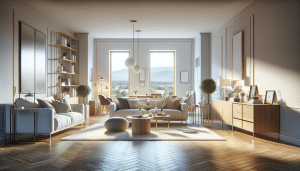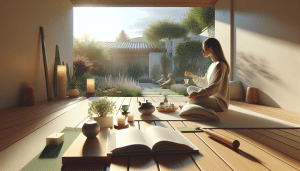Can You Really Transform Your Space With Minimalist Home Decor
Jessica White October 27, 2025
Step into the world of minimalist home decor and discover how small changes can completely transform your living space. This guide breaks down the essentials of minimalism, from decluttering hacks to design principles, bringing a fresh, serene energy to your lifestyle and environment.
What Is Minimalist Home Decor and Why Is It Trending
Minimalism in home decor has become a buzzword for those seeking simplicity without sacrificing style. The minimalist approach focuses on using fewer elements to create visually calm and organized living spaces. This trend is driven largely by a desire to reduce clutter, streamline daily routines, and promote a sense of tranquility at home. When you select just a few meaningful pieces—such as a sleek sofa, neutral rugs, and carefully chosen artwork—every item stands out more, heightening the appreciation of space and function.
The surge in demand for minimalist home decor stems from a collective move toward intentional living. In a world filled with distractions and noise, many people crave the sanctuary of a tidy, peaceful environment. Minimalism goes beyond aesthetics; it represents a lifestyle change that emphasizes quality over quantity. Thoughtfully curated rooms filled with light, uncluttered surfaces, and functional furniture can significantly influence emotional well-being. Research even shows that a minimalist environment can enhance focus, reduce anxiety, and encourage more mindful living (https://www.health.harvard.edu/mind-and-mood/declutter-your-mind-for-good).
It’s not surprising that minimalist decor trends now appear in everything from social media feeds to interior design shows. Open shelving, natural light, and multi-use furniture score high in popularity as people shift away from excess. Minimalist spaces invite creativity by letting personal items—photos, books, art—shine against a calm backdrop. As this approach grows, experts suggest it could lead to more sustainable consumption habits, making the trend both appealing and practical for the modern lifestyle.
Decluttering Tactics for a Minimalist Home
Decluttering is at the heart of minimalist decor. Begin by sorting belongings into clear categories: keep, donate, recycle. This process encourages deeper thought about what truly adds value to your space. Items that rarely get used or lack sentimental worth can often be given new life elsewhere, either through donation or repurposing. The goal is never to deprive the home, but to let each remaining object serve a purpose or spark joy.
For those overwhelmed by the thought of tackling an entire home, starting with a single room or even a single shelf can build momentum. The popular method known as the ‘four-box technique’—sorting into keep, donate, trash, relocate—gets repeated until each area feels lighter. Many also swear by the rule that for every new item brought in, something old leaves. This steady pace can be more sustainable and less emotionally taxing, making the changes stick for the long term (https://www.nytimes.com/guides/smarterliving/how-to-clean).
Storage can be both beautiful and functional when following minimalist principles. Hidden storage ottomans, floating shelves, and under-bed bins can keep necessary items accessible yet out of sight. The absence of visual clutter is soothing and lets statement pieces become focal points. By consciously resetting surfaces each evening, it becomes easier to uphold the sense of minimalism, turning it into a daily habit that nurtures a calm and organized home.
Core Design Elements of Minimalist Interiors
Minimalist interiors are defined by clean lines, neutral colors, and thoughtful use of texture. The basic color palette typically includes whites, grays, and beiges, with accents introduced through natural materials such as wood, stone, and plants. This palette ensures that rooms feel open, bright, and inviting. Furniture with low, straight silhouettes and unembellished surfaces helps reinforce the minimalist aesthetic.
Lighting plays a pivotal role in minimalist spaces. Ample natural light maximizes the feeling of openness and highlights the careful arrangement of objects. When designing with minimalism in mind, consider large windows, sheer curtains, and strategic placement of mirrors to bounce light throughout the room. Artificial lighting should also be understated—think simple pendant lamps or recessed LEDs that blend seamlessly with the overall design (https://www.architecturaldigest.com/story/how-to-choose-lighting).
Minimalism isn’t about emptiness—it’s about balance. A single bold artwork, a statement vase, or an area rug can transform a room by drawing the eye and imparting personality. Integrating houseplants is another way to bring life into minimalist settings while maintaining a sense of calm. The secret lies in negative space; empty areas are celebrated for their ability to let color, form, and texture breathe rather than overwhelm.
Benefits of Embracing a Minimalist Lifestyle
Many report increased satisfaction and lower stress after switching to minimalist home decor. A tidy environment often leads to a clearer mind, reduced anxiety, and improved productivity. The process itself can be cathartic, as letting go of excess belongings frees up physical and mental resources. This emotional clarity can manifest in countless ways, from improved creativity to better sleep.
Financial benefits may also follow. When mindful of purchases and home upgrades, people tend to focus on quality over quantity. Fewer but better items last longer, are easier to maintain, and can reduce overall spending in the long run. DIY minimalism—upcycling, repurposing, or simply organizing existing possessions—often costs little or nothing but yields dramatic results (https://www.moneyunder30.com/declutter-and-save-money).
Environmentally conscious minds may also find appeal in minimalism. With fewer items consumed and wasted, there’s a smaller environmental footprint. Choosing sustainable, durable pieces and reducing unnecessary consumption aligns the minimalist philosophy with popular eco-friendly principles. In this way, embracing minimalist decor can become about more than visual appeal; it’s a chance to make lifestyle choices that are healthy for both individuals and the planet.
Practical Steps to Start Your Minimalist Home Journey
Starting small is the most manageable way to shift towards minimalist living. Begin with a single drawer or a corner of one room. Remove everything, clean the area, and only put back items you actively need or genuinely enjoy. This process builds confidence and can spark the momentum needed to tackle larger projects. Each success, no matter how tiny, builds toward lasting change.
Tuning mindset as well as environment is key. Consider documenting progress with photos, lists, or even a journal. Reflecting on how spaces feel can reveal what works for you and what doesn’t, helping to guide next steps. It may help to study minimalist inspirations—including books and digital minimalism guides—for both practical strategies and motivational stories. Sweep out physical clutter, but also digital noise that adds to daily overwhelm (https://www.brookings.edu/articles/simple-living-for-new-times/).
No need to rush. Minimalism is a journey, not a race. Consider scheduling regular check-ins—weekly or monthly—to reassess, reset, and readjust as your needs change over time. Invite loved ones to experience the process, or seek out online minimalist communities to share progress and challenges. Over time, minimalist habits can become second nature, turning every home into a personalized sanctuary.
Integrating Minimalism Into Entertainment and Lifestyle
Minimalism doesn’t stop at decor. It can influence every aspect of your lifestyle, from how you entertain guests to your daily routines. Many minimalist hosts find joy in intimate gatherings—focusing on meaningful conversation, simple menus, and uncluttered tablescapes. These moments highlight the value of experiences over excess, creating connections that linger far longer than fleeting trends or elaborate décor ever could.
Simplifying entertainment choices elevates quality time. Activities like reading together, board games, or mindful walks often foster deeper bonds than high-budget amusements. Even digital entertainment can align with minimalist values by curating playlists, organizing devices, and favoring content that enriches rather than overwhelms. Balancing screen time with real-world activities leads to a more intentional lifestyle overall (https://www.psychologytoday.com/us/basics/minimalism).
Incorporating minimalist values can also improve mental clarity and satisfaction beyond your home. Time saved on cleaning, shopping, or managing possessions can be reinvested in personal growth, hobbies, or relationships. Minimalism, integrated into both entertainment and everyday routines, has the power to create a more fulfilling and balanced lifestyle. A little simplicity goes a long way, not just in decorating a space, but in shaping a richer way of living.
References
1. Harvard Health Publishing. (n.d.). Declutter your mind for good. Retrieved from https://www.health.harvard.edu/mind-and-mood/declutter-your-mind-for-good
2. The New York Times. (n.d.). How to clean your home. Retrieved from https://www.nytimes.com/guides/smarterliving/how-to-clean
3. Architectural Digest. (n.d.). How to choose lighting for your home. Retrieved from https://www.architecturaldigest.com/story/how-to-choose-lighting
4. Money Under 30. (n.d.). Declutter and save money. Retrieved from https://www.moneyunder30.com/declutter-and-save-money
5. Brookings Institution. (n.d.). Simple living for new times. Retrieved from https://www.brookings.edu/articles/simple-living-for-new-times/
6. Psychology Today. (n.d.). Minimalism. Retrieved from https://www.psychologytoday.com/us/basics/minimalism








